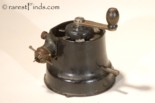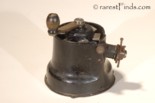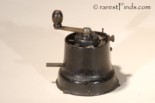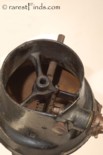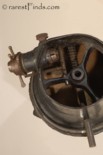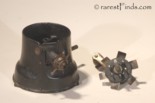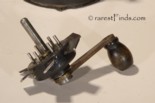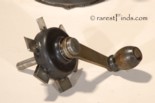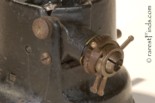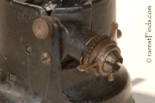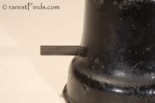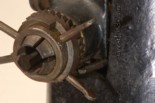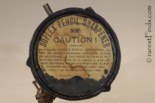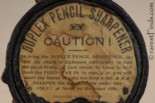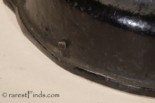One of two known, and the only one in private hands, THE DUPLEX Babcock Pencil Sharpener, Sold!
Patents, click on any image to see larger image!


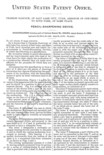


The Duplex Babcock pencil sharpener was patented on October 2, 1900, and the patent with number 658,824 was issued to Charles Babcock from Salt Lake City, Utah, USA. The antique DUPLEX Babcock pencil sharpener is among the rarest antique pencil sharpeners ever produced; the reason is a simple one. This antique pencil sharpener is awkward to operate and has other flaws. Only very few were sold. I assume this for several reasons: There are only two known to exist, the one offered here still has its original paper-label on the wooden bottom. This label provides a cautionary label which announces the shortcoming of the DUPLEX. The Label reads:
DUPLEX PENCIL SHARPENER
In using the DUPLEX PENCIL SHARPENER, see
CAUTION!
that the chuck is tightened sufficiently to hold
the pencil firmly. Care should be taken to NOT
push the FEED-BAR IN to rapidly or you will
cause the blades to take too dep a cut.
Sharpen the blades on the under side
ONLY! Never on the upper side.
PATENTED OCTOBER 2, 1900
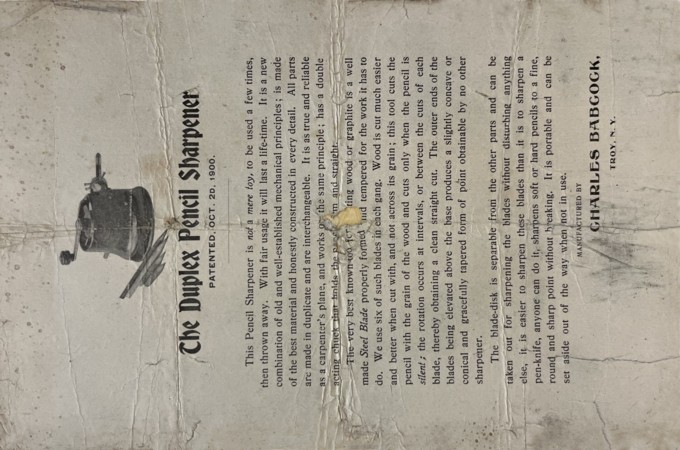 In fact, it is difficult to hold the pencil with the chuck so that it does not slide while the knifes cut the wood, reading the instructions on the left below it becomes clear that you actually needed three hands to operate this pencil sharpener. This may be one of the reasons the DUPLEX Babcock was a commercial failure. One of the levers of the chuck holding the pencil is actually bent on the DUPLEX Babcock at
the National Museum of American History
as you can see in one of the pictures on the website of the
earlyofficemuseum.com.
Picture 10 shows the chuck in its closed position; picture 11 shows the chuck in its fully open position.
In fact, it is difficult to hold the pencil with the chuck so that it does not slide while the knifes cut the wood, reading the instructions on the left below it becomes clear that you actually needed three hands to operate this pencil sharpener. This may be one of the reasons the DUPLEX Babcock was a commercial failure. One of the levers of the chuck holding the pencil is actually bent on the DUPLEX Babcock at
the National Museum of American History
as you can see in one of the pictures on the website of the
earlyofficemuseum.com.
Picture 10 shows the chuck in its closed position; picture 11 shows the chuck in its fully open position.
The insert with the six knifes, the six pins to turn the pencil, and the removable crank, is partially made of a pot-metal casting. This pot-metal casting is holding the knifes and pins in place. Pot metal derives its name from the pot in which all kinds of metals in all kinds of mixtures were thrown into and then melted; typically Copper, Lead, Zinc, Aluminum, Antimony, Magnesium and others. Iron was not among the metals as iron would lead to an unwanted increase of the melting point. There are better and worse pot metals but they all have in common that they are cheap and unstable. Especially parts exposed to stress fall apart easily. At the time, long-term behavior of pot-metal was unknown.
Because the insert was not attached to the antique pencil sharpener other than gravity, turning the machine upside-down would cause the insert to fall to the floor and inevitably break into pieces. This had to happen only once and the pencil sharpener was useless!
As mentioned above,the only other DUPLEX or Babcock pencil sharpener known to exist can only be touched wearing gloves and is among the collection in the National Museum of American History in Washington. The knife assembly of that machine is already disintegrating and one of the six knifes broke off and is already missing. The bottom wooden cover with label is also missing on that DUPLEX Babcock pencil sharpener.
The antique Duplex Babcock pencil sharpener offered here is the only one in private hands, and the only one which is complete. The part made of pot-metal is replaced by a part made to scale out of steel by a skilled machinist.
Condition:
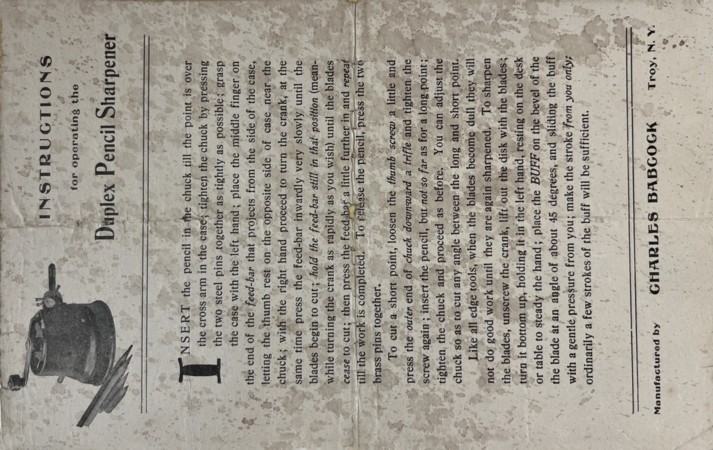 The insert with the six knifes, originally manufactured utilizing cheap instable pot-metal was missing and has been meticulously made by a talented machinist with the help of Carlene Stephens, curator of the Division of Work & Industry of the National Museum of American History, see pictures 6, 7 and 8. She provided many pictures and measurements. She also emailed me the two pictures of the instructions and advertising pamphlet shown here. Thank you very much Carlene Stephens!
The insert with the six knifes, originally manufactured utilizing cheap instable pot-metal was missing and has been meticulously made by a talented machinist with the help of Carlene Stephens, curator of the Division of Work & Industry of the National Museum of American History, see pictures 6, 7 and 8. She provided many pictures and measurements. She also emailed me the two pictures of the instructions and advertising pamphlet shown here. Thank you very much Carlene Stephens!
The mechanism has some light surface oxidation. The machine is complete and works, not perfect, but that was never the case anyway. This pencil sharpener is in as found condition; no attempt was made to clean it. Everything moves freely as intended.
Picture 10 shows a knurled set screw by which the angle of the cutting can be adjusted; the chuck can be slanted more or less. This allows for a more or less pointed pencil as described in the INSTRUCTIONS shown on the left.
Reading the instructions it becomes clear that the machine was awkward to operate. The reader may realize that the instructions reveal that the chuck was not under pressure while the machine was used as this would have required a second operator or a third hand by a single operator!
History:
This very Duplex Babcock pencil sharpener offered here was first sold on eBay on August 19, 2017, with the knife assembly/insert missing. I assume that a collector of antique pencil sharpeners bought it. The very same DUPLEX Babcock showed up again at Dan Morphy's Auction on April 21, 2023.
There are many active links in this description; every text in bold/italic is a link!
The DUPLEX Babcock was part of a collection of 67 pencil sharpeners sold by Morphy's Auction, and was sold as lot 2626 together with three other pencil sharpeners. There is no doubt that the antique DUPLEX Babcock pencil sharpener offered here is the very same as the one sold on eBay and later at Morphy's auction. There is still a picture of the label of the one sold on eBay on the
Worthpoint.com
website. Click on the second picture to see the label. The label in that picture has the very same imperfections as the one pictured in picture 14 and 15. The label was lose and I stabilized the label with water based glue which created the stains seen in picture 14 and 15.
The only other picture the reader will find of the antique DUPLEX pencil sharpener on the internet is on the webpage of the Early Office Museum at earlyofficemuseum.com. The National Museum of American History inventory number 330110 is clearly readable in one of the pictures shown at the Early Office Museum website showing the top-view of the DUPLEX,
click here
to see that picture. The inventory number is written on one of the labels which are attached to the hand-crank of the DUPLEX pencil sharpener. The reader can also see that there is one of the knifes missing. The inventory number of the DUPLEX/Babcock pencil sharpener shown on the website of
the National Museum of American History is clearly visible and is ME330110.
There are no other records or pictures to be found on the internet, none! I also personally know many top collections and I have never seen another antique DUPLEX/Babcock pencil sharpener in any collection other than the one in the Museum of American History in Washington.
Inventory Number 09364;
Price: Sold!
